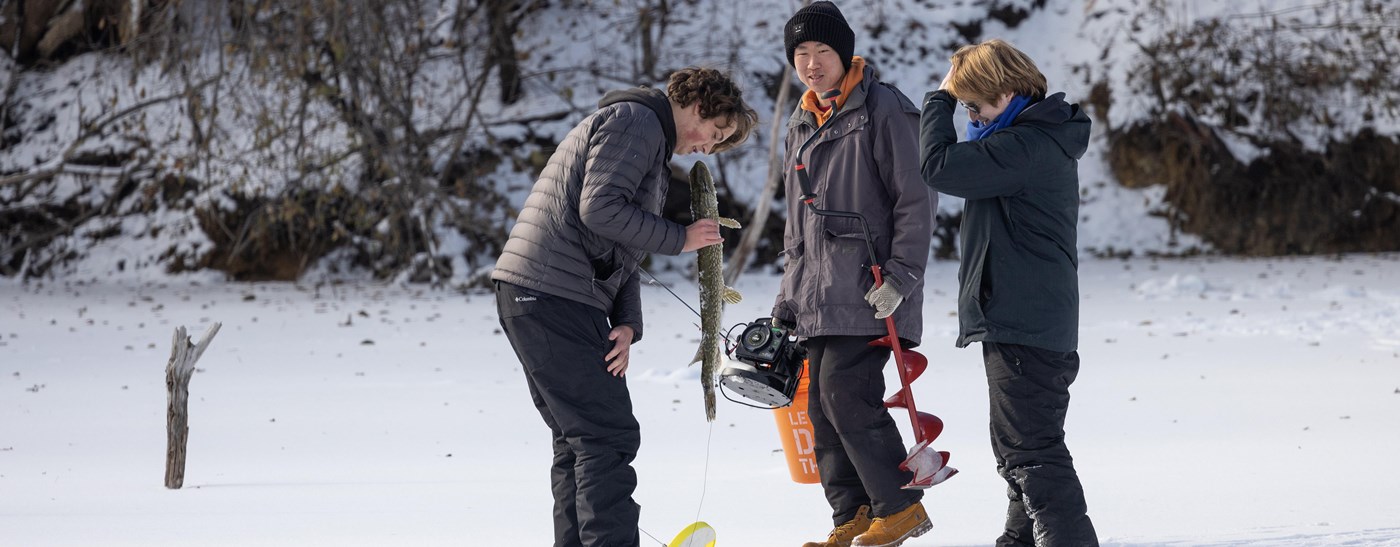
Don’t pack away your fishing gear when the temperature drops. The fish keep biting under the ice, so dress warmly and give ice fishing a try.
Ice fishing is permitted only on the designated bodies of water listed below and is at your own risk. Ice conditions are not monitored by the Lake County Forest Preserves. Anglers should check ice thickness before going out onto any frozen body of water. A minimum of 4 inches of solid ice over the entire water body is recommended before attempting to ice fish.
Bring your own gear. Temporary shanties and shelters are permitted but must be removed by the end of the day. Only two poles are allowed, or tip-ups with no more than two hooks on each line. Holes must be drilled six inches or smaller in diameter. All other fishing regulations apply.
Designated Ice Fishing Locations and Hours
When conditions allow, you can ice fish at one of five great locations, 6:30 am–sunset, daily:
-
-
Independence Grove: permitted on any part of the lake apart from the ice skating area west of the Marina, catch-and-release fishing is mandatory. View
map.
-
-
-
Van Patten Woods: permitted on any part of Sterling Lake. Ice fishing is open extended hours 6:30 am–one hour after sunset, daily. View
map.
Map of Designated Ice Fishing Locations
Check the map below before heading out to the preserves. View a larger map.
Rules and Regulations
State of Illinois sport fishing regulations apply. Anglers ages 16 and older must have a valid Illinois fishing license. Purchase one through the Illinois Department of Natural Resources, at a local sporting goods stores.
Catch-and-release fishing is an important part of maintaining good populations and is mandatory at Independence Grove. At the other preserves, we highly encourage you to release bass or other predator fish you do not intend to keep. These predator fish help to keep panfish populations in balance.
Catch and release tips »
-
Land a fish as soon as possible. Exhausting a fish lowers its chance of survival.
-
When possible, do not use a net. Nets remove a fish’s protective slime.
-
Always wet hands before handling fish. This protects the protective slime.
-
Use barbless hooks for easier hook removal.
-
Keep fish in the water while removing the hook.
-
Handle toothless fish by gripping the lower jaw.
-
Handle fish with teeth behind the gill covers.
-
Never grab a fish directly on the gill covers.
-
Never grip a fish around the abdomen.
-
Never grip a fish by depressing the eyes.
-
If a fish swallows the hook do not attempt to remove it. Cut the line as close to the hook as possible and return the fish to the water.
-
Gently place the fish in the water upon release; never throw a fish back.
Equipment and clothing tips »
-
Dress
-
Warm mittens, two pairs
-
Insulated footwear
-
Hat or hood
-
Towel to keep hands dry
-
Dress in layers
-
Ice creepers on snowless lakes
-
Equipment
-
Ice fishing jig poles, one or two
-
Ice jigheads, size #10 or #12
-
Grubs for baiting jigs, like waxworms or mousies
-
Bobbers, sinkers and thin-diameter line (4–6 lb)
-
Ice auger
-
Strainer
-
5-gallon bucket
-
Live minnows
-
Depth finder
-
Safety
-
A uniform 4.5-inch layer of ice is required, and the area must be posted safe for fishing
-
Ice is weaker around water protrusions, like springs and currents
-
Avoid “black ice”
-
Techniques
-
Move to a new spot if you don't receive a bite in 30 minutes
-
Jig small and slowly, and in small increments
-
Walk softly, stay on the snow
-
Try different depths
-
Release fish quickly